These Chickpea Dumplings Are a High-Fiber Hug in a Bowl
And this recipe makes a frequent appearance on my weekly dinner menu.

Leigh Beisch
Reviewed by Dietitian Annie Nguyen, M.A., RD
I know I'm not alone when I say the pandemic changed how my household shopped and ate. My husband, Dan, became obsessed with bulk-ordering food, especially our major household staples, chief among them dried chickpeas.
Ever since I was diagnosed with high cholesterol in 2017, I have tried to exceed the recommended 21 to 25 grams of fiber every day. Only 7% of adults eat enough fiber, and I'm determined to be among them. When people ask me about managing cholesterol with diet, I tell them that I follow a plant-based plan. But I always stress that what you do eat is vastly more important than what you don't eat. Fiber-rich foods, including whole grains, vegetables and legumes, are powerful weapons in the war against cholesterol. And my favorite source of fiber is the mighty, the versatile, the humble chickpea.
That's why, in the spring of 2020, we got 50 pounds of dried chickpeas delivered to our door from Palouse in Washington State. We actually intended to get "only" 25 pounds, but you may remember the food supply panic and shipping delays of March 2020. When the first 25-pound bag of chickpeas we ordered was delayed, seemingly lost in the postal system, Palouse generously sent us another. A week later, both bags arrived at the same time.
If you're wondering, a pound of dried chickpeas weighs three pounds after it's cooked. So, that 50 pounds netted out to 150 pounds of fiber-rich food. I did the math—50 pounds of dried chickpeas contains 2,744 grams of dietary fiber. And yes, we ate them all—and ordered another 25 pounds about six months ago.
How did I cook all those chickpeas? In many different ways—the chickpea is a shapeshifter—but my favorite way was in this recipe for Chickpea Dumplings in Curried Tomato Sauce. Its frequency on my meal plan accelerated when Dan got the Kitchenaid Grain Mill attachment. This was shortly after he'd acquired a German oat flaker (months before Gwenyth Paltrow's Goop featured a similar model as a recommended gift for the 2020 holiday season), but I digress.
Of course, this recipe works perfectly with store-bought chickpea flour. In fact, I'd made it many times that way before my husband became a full-fledged pandemic-era homesteader. Though I will admit, there's a depth of flavor and freshness you get with home-ground chickpea flour. Just be sure to grind your chickpeas to a powder-fine texture.
Either way, store-bought chickpea flour or fresh ground, the dumplings are a marvel. The first time I made them, I appreciated how comforting the dish was. The dumplings are tender but not crumbly—the ideal savory morsel to carry the gently spicy sauce. I loved how the leftovers improved overnight in the refrigerator.
Related: How Long Are Leftovers Good For?
The recipe was first published in the October 2019 print issue of EatingWell. I tore the page out of the magazine and three-hole-punched it for my kitchen binder of special favorites. I made it a few times that fall. Little did I know how much I was going to need that comfort in the coming months and years.
It's possible I tend more toward emotional eating than others. Tough day at work? Have a few oil-cured olives. Argument with Dan? A little peanut butter and strawberry jam toast will make it right. More rejections that are simply part of a writer's work and life? Let a few dark chocolate chips take the edge off.
I don't beat myself up about this anymore. It's deeply human to console ourselves with food, and these last few years, I've needed a whole lot of comfort. Who hasn't? At this point, I don't foresee this ever not being the case. Bring on the snacks as we endure what has been called, accurately, the permacrisis.
I never begrudge myself food or even treats, but when I find something that is both comforting and wholesome, I double down. This dish is as soothing as any I can think of, a veritable weighted blanket for my insides. It also just so happens to have 13 grams of dietary fiber as well as 12 grams of plant-based protein. This combo of attributes can be difficult to find.
And the recipe is easy to make, coming together in under an hour and using primarily pantry and refrigerator staples I always have on hand. I use plant-based yogurt, but I've also used plain soy milk thickened with a little lemon juice in a pinch. Fresh spinach or mustard greens is my first choice, but I have substituted a couple of handfuls of frozen spinach, defrosted and squeezed dry of excess moisture. If I don't have a serrano or jalapeno handy, I add a pinch of cayenne or omit it. The other pantry spices—coriander, cumin, mustard seeds and curry powder—can pick up the slack.
As we move into the cold weather months, I look forward to returning to this high-fiber hug in a bowl all winter. I've definitely got the chickpea supply to make it as often as my emotional needs demand—on repeat all winter long.
Up Next: Plant-Based Diet for Beginners: Your Guide to Getting Started
Read the original article on Eating Well.

